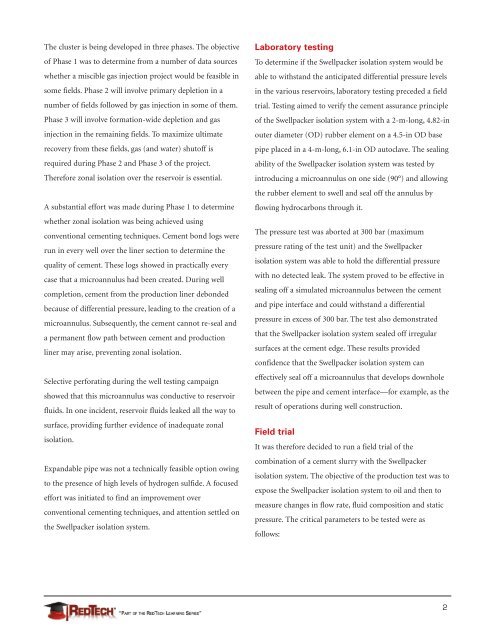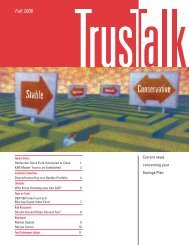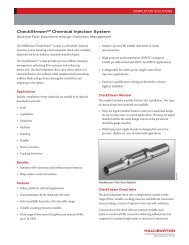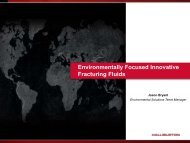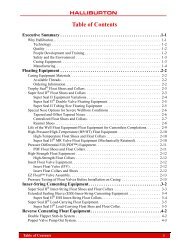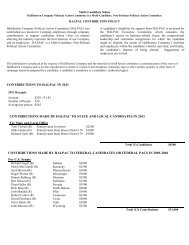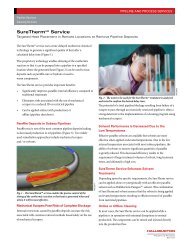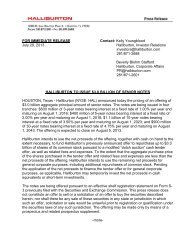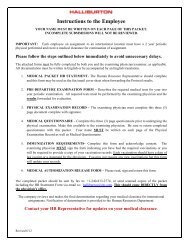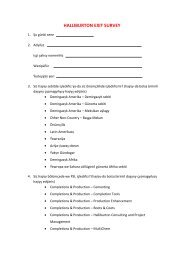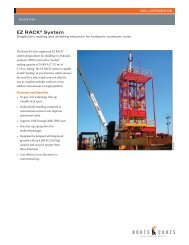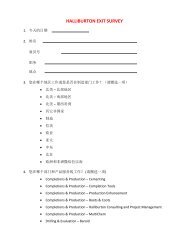Swellpacker™ System Delivers Step Change in Zonal ... - Halliburton
Swellpacker™ System Delivers Step Change in Zonal ... - Halliburton
Swellpacker™ System Delivers Step Change in Zonal ... - Halliburton
You also want an ePaper? Increase the reach of your titles
YUMPU automatically turns print PDFs into web optimized ePapers that Google loves.
The cluster is be<strong>in</strong>g developed <strong>in</strong> three phases. The objective<br />
of Phase 1 was to determ<strong>in</strong>e from a number of data sources<br />
whether a miscible gas <strong>in</strong>jection project would be feasible <strong>in</strong><br />
some fields. Phase 2 will <strong>in</strong>volve primary depletion <strong>in</strong> a<br />
number of fields followed by gas <strong>in</strong>jection <strong>in</strong> some of them.<br />
Phase 3 will <strong>in</strong>volve formation-wide depletion and gas<br />
<strong>in</strong>jection <strong>in</strong> the rema<strong>in</strong><strong>in</strong>g fields. To maximize ultimate<br />
recovery from these fields, gas (and water) shutoff is<br />
required dur<strong>in</strong>g Phase 2 and Phase 3 of the project.<br />
Therefore zonal isolation over the reservoir is essential.<br />
A substantial effort was made dur<strong>in</strong>g Phase 1 to determ<strong>in</strong>e<br />
whether zonal isolation was be<strong>in</strong>g achieved us<strong>in</strong>g<br />
conventional cement<strong>in</strong>g techniques. Cement bond logs were<br />
run <strong>in</strong> every well over the l<strong>in</strong>er section to determ<strong>in</strong>e the<br />
quality of cement. These logs showed <strong>in</strong> practically every<br />
case that a microannulus had been created. Dur<strong>in</strong>g well<br />
completion, cement from the production l<strong>in</strong>er debonded<br />
because of differential pressure, lead<strong>in</strong>g to the creation of a<br />
microannulus. Subsequently, the cement cannot re-seal and<br />
a permanent flow path between cement and production<br />
l<strong>in</strong>er may arise, prevent<strong>in</strong>g zonal isolation.<br />
Selective perforat<strong>in</strong>g dur<strong>in</strong>g the well test<strong>in</strong>g campaign<br />
showed that this microannulus was conductive to reservoir<br />
fluids. In one <strong>in</strong>cident, reservoir fluids leaked all the way to<br />
surface, provid<strong>in</strong>g further evidence of <strong>in</strong>adequate zonal<br />
isolation.<br />
Expandable pipe was not a technically feasible option ow<strong>in</strong>g<br />
to the presence of high levels of hydrogen sulfide. A focused<br />
effort was <strong>in</strong>itiated to f<strong>in</strong>d an improvement over<br />
conventional cement<strong>in</strong>g techniques, and attention settled on<br />
the Swellpacker isolation system.<br />
Laboratory test<strong>in</strong>g<br />
To determ<strong>in</strong>e if the Swellpacker isolation system would be<br />
able to withstand the anticipated differential pressure levels<br />
<strong>in</strong> the various reservoirs, laboratory test<strong>in</strong>g preceded a field<br />
trial. Test<strong>in</strong>g aimed to verify the cement assurance pr<strong>in</strong>ciple<br />
of the Swellpacker isolation system with a 2-m-long, 4.82-<strong>in</strong><br />
outer diameter (OD) rubber element on a 4.5-<strong>in</strong> OD base<br />
pipe placed <strong>in</strong> a 4-m-long, 6.1-<strong>in</strong> OD autoclave. The seal<strong>in</strong>g<br />
ability of the Swellpacker isolation system was tested by<br />
<strong>in</strong>troduc<strong>in</strong>g a microannulus on one side (90°) and allow<strong>in</strong>g<br />
the rubber element to swell and seal off the annulus by<br />
flow<strong>in</strong>g hydrocarbons through it.<br />
The pressure test was aborted at 300 bar (maximum<br />
pressure rat<strong>in</strong>g of the test unit) and the Swellpacker<br />
isolation system was able to hold the differential pressure<br />
with no detected leak. The system proved to be effective <strong>in</strong><br />
seal<strong>in</strong>g off a simulated microannulus between the cement<br />
and pipe <strong>in</strong>terface and could withstand a differential<br />
pressure <strong>in</strong> excess of 300 bar. The test also demonstrated<br />
that the Swellpacker isolation system sealed off irregular<br />
surfaces at the cement edge. These results provided<br />
confidence that the Swellpacker isolation system can<br />
effectively seal off a microannulus that develops downhole<br />
between the pipe and cement <strong>in</strong>terface—for example, as the<br />
result of operations dur<strong>in</strong>g well construction.<br />
Field trial<br />
It was therefore decided to run a field trial of the<br />
comb<strong>in</strong>ation of a cement slurry with the Swellpacker<br />
isolation system. The objective of the production test was to<br />
expose the Swellpacker isolation system to oil and then to<br />
measure changes <strong>in</strong> flow rate, fluid composition and static<br />
pressure. The critical parameters to be tested were as<br />
follows:<br />
2


